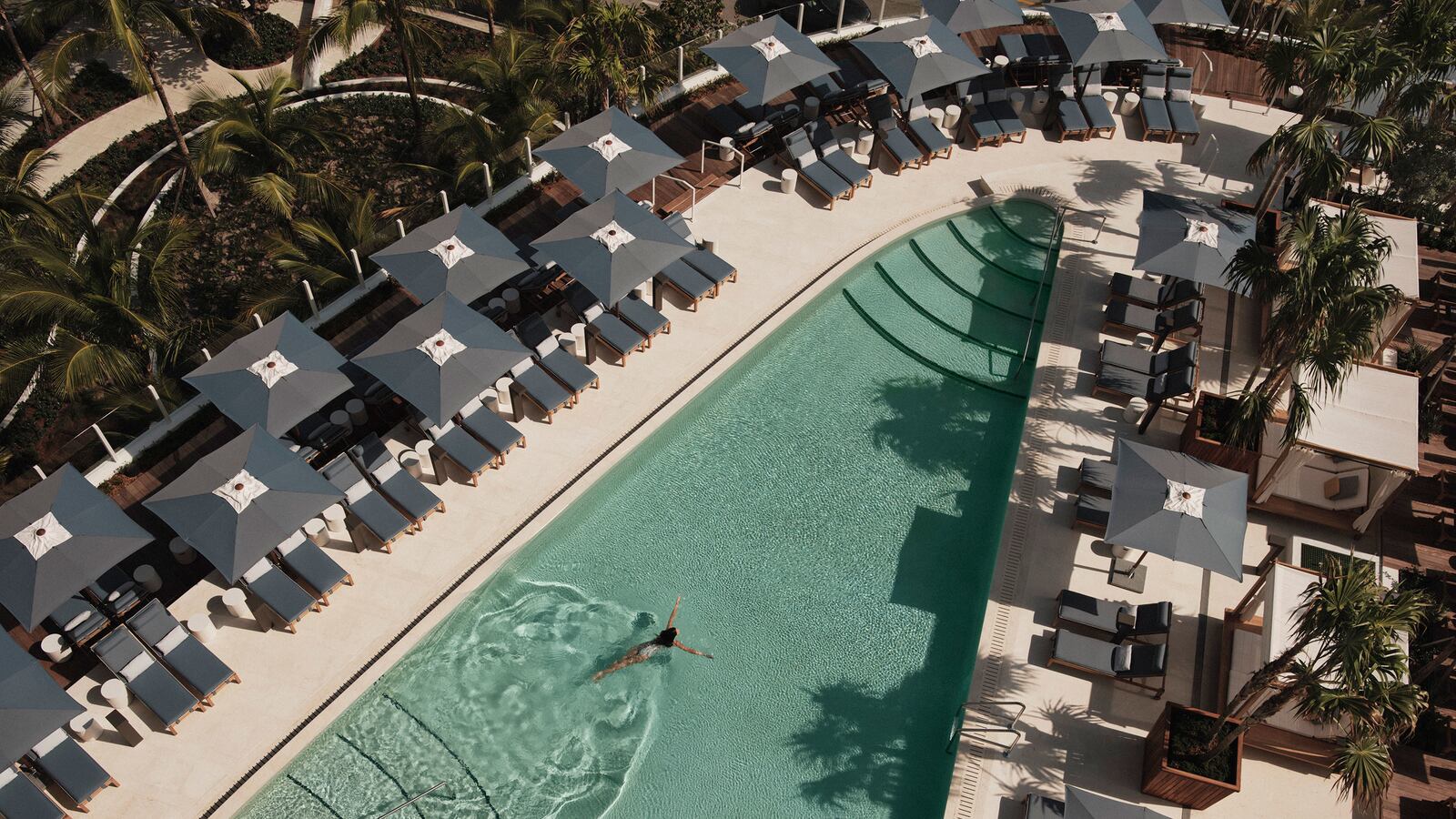It looks, at a glance, like every white-and-glass tropical tower from Rio de Janeiro to South Florida, but a second look reveals something startling about the new Four Seasons Fort Lauderdale, designed by Kobi Karp. It plows its way out of the oceanfront skyline here, its shape leaving no doubt as to its inspiration from the ships that dot the horizon. The feeling of being on a ship, or actually, of being anywhere other than Fort Lauderdale as you imagined it, is a central part of this truly fabulous new hotel’s experience which is the latest selection for our series on exciting new hotels, Room Key.
When the hotel invited Beast Travel to visit, we asked for recommendations on social media as we’d never ventured here except to fly in and out en route to Miami. The responses were telling: “Just don’t go” or “Get in an Uber to Miami” were the gist of the replies. But then messages trickled in from locals or frequent visitors who swore that the city was actually a gem whose reputation is part of what allows it to keep its charm. Miami may be awash in money with a crazy party scene, elite restaurants, and glamour, they said, but Fort Lauderdale has the same beach without the crime or the pressure to keep up with the Joneses. Miami is no longer relaxing, they claimed, but Fort Lauderdale still is.

The hotel’s aesthetic is mid-century modern meets Caribbean meets yacht, a combination that hits you full-force when you first walk in. A two-floor tropical Neutra-esque atrium takes up most of the lobby and will have you whipping out your phone for a social media-friendly shot. Tucked behind a sharp-edged staircase and curtain of grayish-brown marble wall are the elevators, which take you up to the rooms, restaurant, gym, and spa. A detail we’ve come to appreciate lately at Beast Travel is how a hotel does its hallways–are they dreary and drab? A place merely to scurry through on your way to your room? A chance for the designer to show some creativity and flair? Here at the Four Seasons Fort Lauderdale, the first thing you notice is that the nautical blue and white striped carpeting is so plush you nearly sink into it, largely the result of its newness but a godsend to those who like quieter hotels. Tara Bernerd, the designer who oversaw the interior decoration, livened up the spaces with one simple but lovely touch–walls broken up by large wood frames of taupe canvas.
There are 189 rooms and suites (and 41 residences) in the tower that either have a view of the ocean in front or the verdant islands of the Intracoastal Waterway to the rear. The rooms are simple, uncluttered, and airy, with nods to the yacht aesthetic with the lacquered woods and the lines of the built-in side table and desk. The tropical comes both with the view and the rattan covered closets.

The third floor is where most people will end up, whether you’re staying at the hotel or not. The spa with its signature massages and facials can be found here (try the Ebb & Flow) as well as its large gym. It’s also where one can find Evelyn’s, the property’s signature restaurant helmed by irrepressibly charming chef Brandon Salomon. The restaurant, designed by Martin Brudnizki, looks like a fairy godmother put a casual beach town restaurant through a filter labeled “Upscale.” Salomon has taken the kind of cuisine many of us want to be eating in warm weather by the sea—Eastern Mediterranean—and made it just a bit more decadent. See, for instance, the truffles in the hummus. In front of the restaurant are the hotel’s main pools, one for all ages and one for adults only. As you lounge on the ledge here, the street and beach below are no longer in view, giving you the illusion of being on one of those cruise ships.
The hotel is located right on North Fort Lauderdale Beach Boulevard on a stretch peppered with properties from major hotel chains. Most visitors will likely pass their time at the pool or across the street on the beach. (To feel like you’re really not having the “typical” Fort Lauderdale experience, have the hotel arrange one of their picnic baskets for the beach–it will be filled with charcuterie, cheeses, lunch, desserts, and champagne.)

Around the corner from the hotel is Bonnet House & Gardens, a house museum that belonged to one of the families that were among the first to move here from the north (to an existing Seminole community) at the end of the 19th century seeking warmth and calm. Today it is an oasis frozen in time, a time when Florida was on the cusp of overnight becoming the Florida we know today. The house was built by wealthy Midwesterners Helen and her husband, Frederic Clay Bartlett, True Value heir and an amateur architect. Whereas Mediterranean Revival would become Florida’s dominant style, Bartlett designed this estate in a mixture of styles, but the most tangible is Caribbean. The sunny yellow house is enmeshed in a lush garden of palms and leafy brush. Bartlett was a painter who had studied at the Royal Academy in Munich, and so the house is decorated from lintel to floor by his brush. If Vizcaya in Miami encapsulates all the glitz that eastern Florida would come to symbolize, Bonnet encapsulates the eccentricity of those who came to call Florida home. Take, for instance, the dining room, which is Old Florida meets Bavarian hunting lodge, or one of the exterior passageways (there are no interior stairs) decorated with mosaics of shells found on the nearby shore. Bartlett’s second wife and widow, Evelyn Fortune Lilly, the ex-wife of Eli Lilly, lived to 106 years old and left the property as a museum. The restaurant at the Four Seasons is named for her.
The house museum is one of the two main attractions in the city–the other being the water taxis from which you can gawk at all the McMansions lining the dozens of islands–but Fort Lauderdale’s charm isn’t from a list of things to do when you visit. It’s that, outside of spring break, there might be few places left that are this laid back, this unbothered, this detached, from everything. Flip-flops and cargo shorts in snazzy waterfront restaurants, a boardwalk full of unhurried runners every morning, a city that to the first-time visitor just seems wonderfully blasé.

With rapidly changing tastes and staffing issues, many hotel groups have struggled of late to deliver the experience that visitors associate with their brand. The Four Seasons Fort Lauderdale, however, is exactly what you imagine a Four Seasons to be, and it just might help your jaded self see this city in a whole new light.






